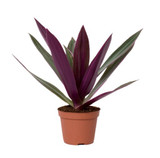
Pineapple Plant - stops snoring!
Pineapple plants (Ananas comosus) have recently been taking the house plant world by storm. It’s easy to see why: the idea of growing a tropical pineapple in your home is very appealing. The plants are attractive, too, with a rosette of spiky, exotic-looking leaves and an interesting flower spike.
Pineapple mania first took off in the UK in the 1700s, after the edible fruits had been introduced to Europe from south America by Spanish conquistadors. They were grown in the grounds of large houses and shown off at the dinner tables of the wealthy. They were a real status symbol, as growing a tropical fruit in the cool UK climate involved the skill of a gardener and the expense of heating a special pineapple house or ‘stove’.
The pineapple is a member of the bromeliad family. In the wild, it grows on the ground and is pollinated by hummingbirds. Like all bromeliads, once it has flowered and has produced a fruit, it will start to die back. However, baby plants (often called pups or offsets) should appear at the base of the plant. These can be potted up and grown on as new plants.
Claims have been made that a pineapple plant close to your bed can reduce snoring as, unusually for a house plant, it produces oxygen during the night. There is no scientific proof of this, however, although like many house plants, the pineapple is a good air purifier.
How to grow a pineapple plant
Grow your pineapple in a mix of orchid compost and peat-free multi-purpose compost in a warm, bright spot. Water when the top few centimetres of compost begin to dry out in spring and summer and keep barely moist at other times. The plant will die back once it has flowered and fruited but should produce more baby plants at the base, which can be potted up and grown on as new plants.
Pineapples do best in a warm room (the warmer the better, but at least 16°C) with plenty of bright light – a conservatory, heated greenhouse or bright windowsill is ideal. Your plant can take some direct sunshine, but too much will scorch the leaves. It’s a good idea to rotate your plant from time to time to stop it leaning to one side.
You can move your pineapple plant outside in the summer months – it will thrive in the high light levels. Make sure you move it back indoors as temperatures fall in autumn.
Water whenever the top few centimetres of compost feel dry in spring and summer; allow any excess to drain away. Keep barely moist in winter.
Snip off any dry leaves and give the occasional dust with a fine brush. Rotate occasionally to ensure even growth. Feed every two weeks with a weak liquid fertiliser in spring and summer and once a month in winter.
If you’re growing an edible pineapple, wait until the pineapple turns orange-yellow in colour, with a sweet smell, before harvesting.
If your pineapple plant is dying back after it has fruited, this is normal. However look out for new baby plants at the base.
Plant not producing a flower spike or fruit? Be patient – a pineapple plant flowers when it’s around two years old and will produce a fruit around six months after that.
Yellow leaves and blackening at the base are due to overwatering. This can kill plants, but it’s worth trying to save it. Take the plant out of its container, removing any affected roots, and pot it up in fresh compost. Don’t over water from then on – the soil needs to be moist but not soggy.
You may notice mealybugs or scale insects on the leaves. Wipe them off with cotton wool soaked in organic insecticide based on plant oils or fatty acids.
You may notice fungus gnats (sciarid flies) around the base of the plant. They’re attracted to moist soil, so let the compost dry out between watering.







